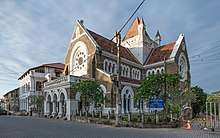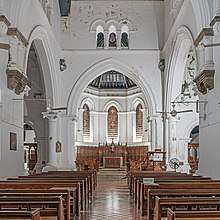All Saints' Church, Galle
All Saints' Church is an Anglican church located within the Galle fort in Galle, Sri Lanka and is located on Church Road.
| All Saints' Church, Galle | |
|---|---|
 | |
| Religion | |
| Affiliation | Anglican, Church of Ceylon |
| Rite | Anglican |
| Year consecrated | February 21, 1871 |
| Status | Active |
| Location | |
| Location | Church Street, Galle fort |
| Geographic coordinates | 6°1′38″N 80°13′2″E |
| Architecture | |
| Architect(s) | J.G. Smithers |
| Type | Church |
| Style | Victorian Gothic Revival |
| Groundbreaking | October 30, 1868 |
| Completed | February 21, 1871 |
| Construction cost | £1,600 |
| Direction of façade | towards south |
| Website | |
| www | |
History

The decision to build an Anglican church at Galle, was initiated by the first Bishop of Colombo, Rt. Rev. James Chapman. The foundation of the church was laid on 30 October 1868, by Rev. Dr. Piers Calveley Claughton, the second Bishop of Colombo. The construction of the church was facilitated by a grant of the land and £600 from the 13th Governor of Ceylon, Sir Hercules Robinson. A further £1,000 contribution was received from an English parish. The church was designed by J.G. Smithers, the government architect, who later designed the National Museum of Colombo. The church was constructed on the site of a former Court House (1780s). The gallows it is said stood on the site of the present altar. The Anglican congregation in Galle which, up to then, worshipped in the Dutch Church. The church was consecrated on 21 February 1871 by Bishop Claughton, assisted by the church's first vicar, Rev. Dr. George Justus Schrader (1829-1875).[1][2]
In recognition of Rev. Dr. Schrader's significant contribution to the church, a large bell was placed in his memory in the centre dome of the church in 1876. In the mid 1960s, for security reasons the bell was lowered and was left to be sold. It was subsequently bought by the diocese and is now housed in the Cathedral of Christ the Living Saviour in Colombo.[3] The current bell was acquired by the church in 1968. The bell came from the Liberty Ship, "Ocean Verity", and was donated by the Clan Line Steamship Company.
The first Baptism at All Saints was Lilian Slade Godolphin Ozanne on 21 February 1871 and the first marriage was held on 25 March 1871, between James Weir and Jane Strene King.
Architecture
It was built on a basilican plan in a Victorian Gothic Revival style of architecture, modified to suit local climate. The plan of the Church is cruciform firmly supported on stone columns and arches carved beautifully in timber. Masonry arches built in local kabuk and lime mortar. The heavy pews, with carvings of the Jewish Star of David, and the sanctuary are all made from Burmese teak.
References
- Claughton, Rev. Bishop (1872). "Last Days in Ceylon". Mission Life, Vol. III. pp. 67–72. Retrieved 1 September 2014.
- "List of Inscriptions on Tombstones and Monuments in Ceylon". Mocavo. Retrieved 1 September 2014.
- "All Saints Church, Galle". Diocese of Colombo. Retrieved 1 September 2014.
External links
- Official website
- One hundred years in Ceylon, or, The centenary volume of the Church Missionary Society in Ceylon, 1818-1918 (1922) Author: Balding, John William Madras: Printed at the Diocesan Press.
- The Church of Ceylon - her faith and mission Published in 1945, Printed at the Daily News Press by Bernard de Silva for the Church of Ceylon.
- The Church of Ceylon: A history, 1945-1995 Editor: Medis, Frederick Published for the Diocese of Colombo.